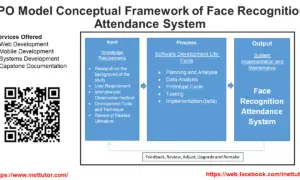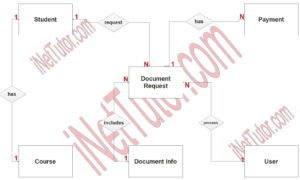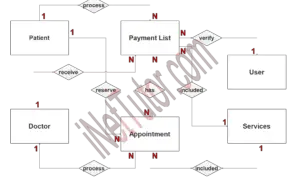Inventory Management System Conceptual Framework
This post will guide you on how to create a conceptual framework for the project Inventory Management System built with Core PHP using input, process, and output (IPO) model.
About the Project
Table of Contents
Inventory Management System built with Core PHP is a capstone project that uses technology in the framework of a business enterprise, specifically in the inventory process. It is used to improve the accuracy and reliability of inventories. This technical solution will improve inventory management or operations in a business where records are kept on an automated platform. This Core PHP-based inventory system is an approach that uses the internet to help businesses manage their inventories more correctly and efficiently. The existing inventory management techniques are likely to be difficult to manage because the company processes data manually without backing it up or storing it. As a result, there are data discrepancies and mistakes. It’s also all too easy to make a mistake and switch details, which can lead to data entry errors or handwritten orders. Reporting takes time and money, necessitates repetitive data entry, and, most critically, is unsecure. This project’s purpose is to fill up the gaps left by the previous one.
Objectives of the Study
- To look at current inventory management systems and see where they might be improved.
- To emphasize the sales and inventory cycle, including the receipt, distribution, and balancing of supplies.
- To provide a system that makes saving and managing files easier while also allowing for optimal file structure and storage.
- To eliminate manual methods to improve the inventory process.
- To create a system that automates the inventory process, alleviating the burden that manual methods entail.
Conceptual Framework
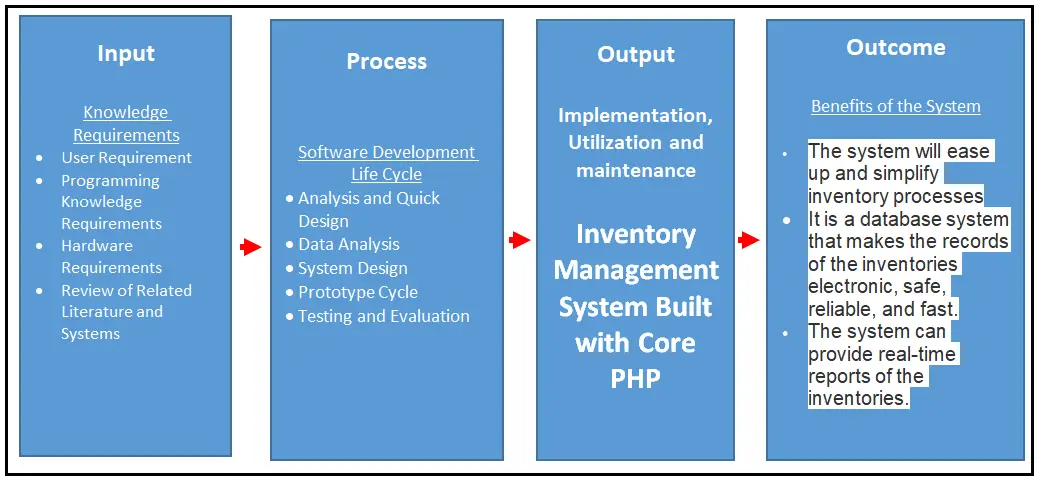
The image above is the conceptual framework of the project entitled Inventory Management System built with Core PHP. It is based on IPO model or also known as the input, process and output model.
What is a Conceptual Framework?
A conceptual framework is an analytical tool that is used to help researchers understand a phenomenon. It is often used in the social sciences, but can be applied to any field of study. The framework provides a structure for the analysis of data, and can be used to generate hypotheses or test theories. It guides researchers in formulating hypotheses and collecting data relevant to the phenomenon under study. In the field of information technology, a conceptual framework may be used to guide the development of new IT applications and systems, and to improve the usability and effectiveness of existing IT systems.
Input
The input phase or the knowledge requirement stage consists of the following:
- User Requirement – the researchers conducted an interview with various companies to identify their needs so that the team can develop the appropriate system that will answer their existing concerns.
- Programming Knowledge – after determining the problems, a solution must be provided and that solution is in a form of information system that will be written in the programming language where the researchers has and adequate knowledge. The researchers will use PHP, MySQL and Bootstrap for the Inventory Management System.
- Hardware Requirements – the system cannot work alone without the hardware such as the computer and mobile devices. The researchers had explained it to the user that they need that hardware to fully utilize information system.
- Related Literature and Systems – the researchers conducted a research on the different literatures and related systems to serve as a guide in the development of the Inventory Management System built with Core PHP.
Process
Analysis and Quick Design
During Analysis and Quick Design, the researchers did a personal interview with the respondents and the chosen client where the study was conducted. The respondents were given the chance to suggest how the system will be designed. After conducting the data gathering, the researchers made an initial design for the proposed system.
Data Analysis
The researchers will analyze all the data, user requirements and information. This phase also help the researchers to have an idea on how to create the system and have an idea on how the proposed system would be beneficial to the clients.
System Design
The researchers will start to develop the proposed system. It includes the design; how the system would look like based on user requirements, and the researchers/programmer would like to add personal design to make the system more interactive and user friendly.
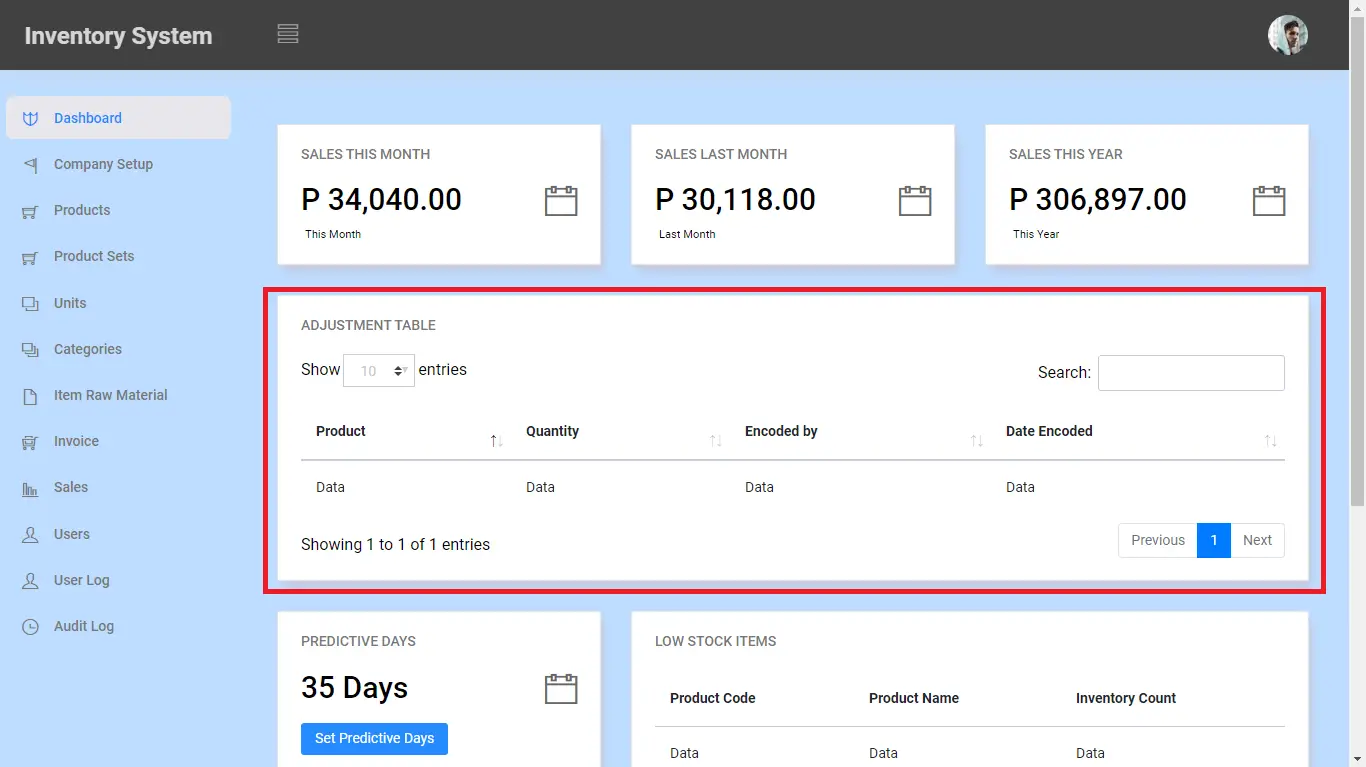
Prototype Cycle
This stage will consist of the researchers’ data being compiled, built, demonstrated, and refined. The researchers create a prototype first, based on the planned design and data tables. The prototype will be shown to the client after it has been built. The researchers demonstrate the system’s operation, the flow of how it operates, and the functions of the system’s features. The next stage is refining, in which the researchers will fine-tune the system based on the client’s extra requirements. Changes to the features flow and functionalities will be made based on the needs.
Testing and Evaluation
This will include the feed backing of the proposed system after it will be implemented and had undergone testing by three Experts. It will also inform the researchers and the developer if there are any bugs, suggestion and if the system’s functionality will works well.
This will discuss the implementation of the propose system wherein Three (3) Experts will evaluate the propose system. This will also discuss if the recommended functions and suggestion are met.
Output
The study’s ultimate output is an automated inventory management system that will replace the conventional inventory system in companies. The system’s implementation is strongly encouraged.
Outcome
Benefits of the System:
- The system will ease up and simplify inventory processes
- It is a database system that makes the records of the inventories electronic, safe, reliable, and fast.
- The system can provide real-time reports of the inventories.
Systems for inventory management can save organizations money in a variety of ways. Businesses should avoid ordering excessive quantities of inventory, which can tie up cash and result in storage costs, by monitoring inventory levels first. Secondly, by monitoring inventory turnover, companies can spot opportunities to optimize processes and cut waste. Thirdly, firms are able to foresee possible shortages and make plans appropriately by monitoring inventory levels in proportion to client demand. Finally, firms may make sure they are always ready for expansion or unexpected changes in the market by employing inventory management systems to foresee future needs.
Summary
The establishment of the study’s conceptual framework is the focus of this research. The researchers used the IPO model as a foundation for developing the conceptual framework in this study. The first stage is the input phase, which consists of User Requirements, Programming Knowledge Requirements, Hardware Requirements, and a Review of Related Literature and Systems. During the process phase, the researchers will develop the system using the Software Development Life Cycle (SDLC) technique. Analysis and Quick Design, Data Analysis, System Design, Prototype Cycle, and Testing and Evaluation are all components of the SDLC technique. The study’s ultimate output is an automated inventory management system that will replace the conventional inventory system in companies. The system’s implementation is strongly encouraged.
Readers are also interested in:
Inventory Management System built with Core PHP
Web-based Inventory System Free Source code in Bootstrap and PHP
Sales and Inventory with Decision Support System in PHP and MySQL
You may visit our Facebook page for more information, inquiries, and comments. Please subscribe also to our YouTube Channel to receive free capstone projects resources and computer programming tutorials.
Hire our team to do the project.
